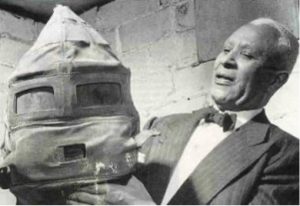
HIGHLIGHTS
A self-made businessman in the apparel and grooming industries, Garrett Morgan’s inventions focused on enhancing the safety of the average worker and citizen.
Garrett Augustus Morgan, Sr. was born in 1877 in rural Kentucky to two freed slaves. His formal education lasted only through sixth grade, when his economic conditions forced him to seek full-time employment. He spent much of his young life working as a handman for a landowner outside of Cincinnati, Ohio and used the income to continue his education with a tutor. When he was eighteen, he left Cincinnati and for Cleveland in search of greater opportunity. There, he found a job as a sewing machine repairman that ignited his lifelong interest in machinery and invention.
While holding jobs in the sewing machine industry, Morgan sold his first invention: a belt fastener for sewing machines. Through his skill and intellectual capability, he quickly became an independent businessman and started his own sewing machine repair shop in 1907. Within just two years, his sewing machine repair business became a tailoring shop that employed over thirty people and later, a women’s clothing store. During this period, Morgan also became integrated in Cleveland’s African American community, helping found the Cleveland Association of Colored Men to support the growth of local Black business.
As a result of his apparel ventures, Morgan was confronted with a problem that led to the invention that would eventually allow him financial freedom. While tailoring woolen fabrics, Morgan’s sewing machines would sometimes be scorched by the heat from the sewing machine needle’s rapid movement. He created a solution to reduce friction during this process and, therefore, eliminate the scorching. But by sheer happenstance, he discovered that his solution had the side effect of straightening coarse fibers. Morgan confirmed this effect by testing the solution on a friend’s wiry-haired dog, and, eventually, on his own hair. Having proven it to be a successful chemical straightener, he began selling his solution as G.A. Morgan Hair Refining Cream, which was wildly successful in the African American community.
Free to pursue his other interests, Garrett Morgan turned his attention to various problems in the working world. He received his first U.S. Patent in 1914 on a “breathing device”—which he called a safety hood—that utilized a mask and tube system to allow the wearer to access a thin layer of unpolluted air close to the ground. The hood garnered local attention in 1916, when an explosion occurred in a tunnel under Lake Eerie and Morgan and his brother used the devices to rescue more than 20 trapped workers after previous rescue attempts had been unsuccessful. Morgan’s hood was also the prototype for the gas masks used during World War I.
In 1923, Morgan obtained a patent on the first automatic traffic signal. At the time, roads were occupied by both horse-drawn carriages and automobiles, resulting in prolific and dangerous collisions at intersections. After witnessing one such collision, he created a device that had a third “warning” position to signal to vehicle operators that a stop was impending. Morgan also received British and Canadian patents on his traffic device before eventually selling the rights to his invention to General Electric for a sizeable sum.
Garrett Morgan continued his invention and community activism until his death in 1963. He received numerous additional patents, including on a women’s hat fastener and a friction drive clutch. In addition to remaining involved with the Cleveland Association of Colored Men, he founded a Black-focused newspaper called the Cleveland Call. Although he considered running for local political office, his health deteriorated and he eventually became blind. He is remembered locally and nationally as a brilliant, hardworking member of the African American community who made great strides for the health and safety of his fellow citizens.
Author: Hannah Mosby O’Brien
